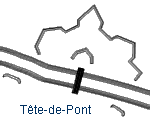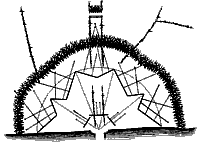 A
bridgehead. Any fortification established to protect a bridge or river crossing
point. The term was usually applied to works thrown up on the enemy's side
of a river to either secure a bridge against attack or provide a reduit to
cover an army's retreat across a river. In his Treatise on Field
Fortification (1862) D. H. Mahan outlined five conditions that effective
têtes-de-pont should meet: A
bridgehead. Any fortification established to protect a bridge or river crossing
point. The term was usually applied to works thrown up on the enemy's side
of a river to either secure a bridge against attack or provide a reduit to
cover an army's retreat across a river. In his Treatise on Field
Fortification (1862) D. H. Mahan outlined five conditions that effective
têtes-de-pont should meet:
1. Allow the defense to continue until all troops have crossed the
bridge;
2. Cover the bridge from enemy artillery fire;
3. Its development and arrangements for passing through the works
should be suited to the size of the army;
4. Its flanks should rest on the river banks and be protected and
flanked by works on the other side of the river;
5. The bridge itself should be protected by a strong interior redoubt.
 Mahan
suggested simple or complex crownworks with two or more bastion fronts of
fortification for larger têtes-de-pont and redans or lunettes with
flanks to cover smaller or less important river crossings. In either case,
a fortification designed to cover a bridge had to be suited to the ground
and could be traced as a line with intervals based on redoubts, a continuous
line, or could consist of a single field work open at the gorge. The route
for the passage of an army through the tête-de-pont was usually directed
around one or both of the flanks or so directed that it passed parallel to
and within close range of the work's faces and was covered by crossing columns
of fire. Mahan
suggested simple or complex crownworks with two or more bastion fronts of
fortification for larger têtes-de-pont and redans or lunettes with
flanks to cover smaller or less important river crossings. In either case,
a fortification designed to cover a bridge had to be suited to the ground
and could be traced as a line with intervals based on redoubts, a continuous
line, or could consist of a single field work open at the gorge. The route
for the passage of an army through the tête-de-pont was usually directed
around one or both of the flanks or so directed that it passed parallel to
and within close range of the work's faces and was covered by crossing columns
of fire.
|